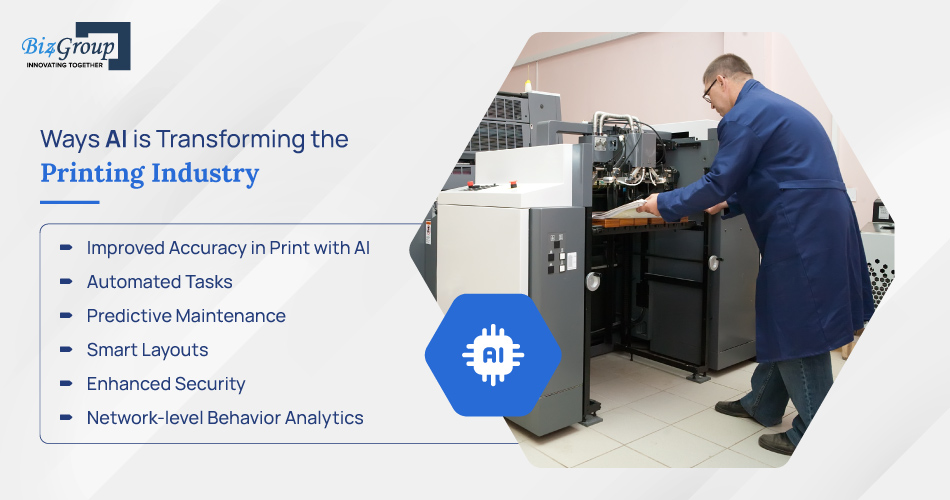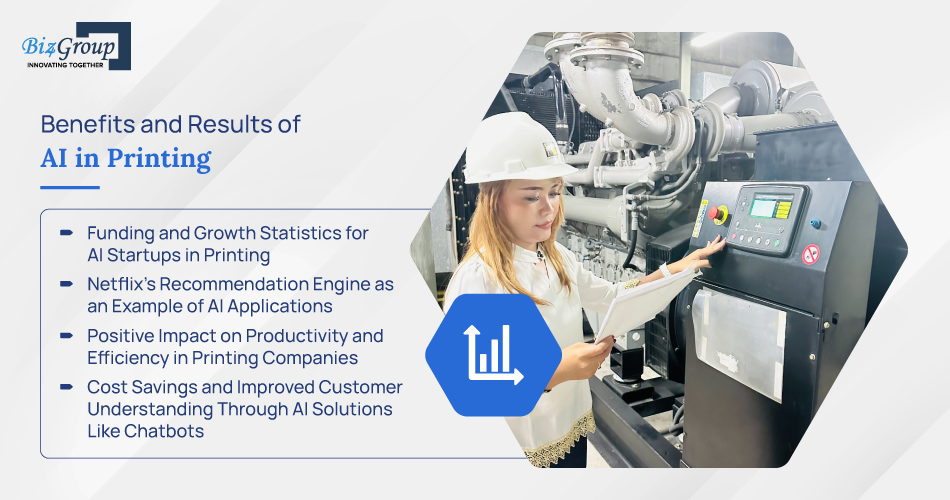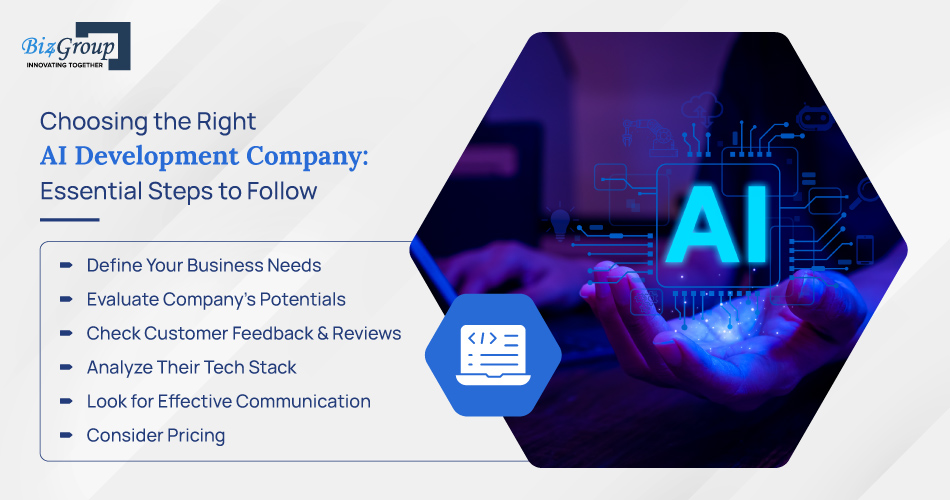How AI is Changing the Printing Industry?
Key Notes
1. Discover the indispensable role of AI in the printing industry, redefining accuracy, efficiency, and security.
2. Delve into the ways AI is implemented in printing, from enhanced accuracy to predictive maintenance and smart layouts.
3. Impact of AI on productivity, customer engagement, and cost savings within printing companies.
4. Understand the costs associated with integrating AI in printing and the essential steps in choosing the right AI development company.
5. Gain insights into the projected growth, challenges, and the futuristic landscape of AI in the dynamic realm of printing.
In the era of rapid technological evolution, Artificial Intelligence (AI) has emerged as a transformative force, reshaping industries and processes. With its widespread impact, AI is not just a technological advancement; it's a paradigm shift. Today, we zoom into a realm where innovation meets precision, exploring the synergy between AI and the printing industry. From enhanced accuracy to predictive maintenance, we unravel the intricate role of AI in printing. Join us on this journey as we delve deep into the implementation of AI in printing, unlocking the potential that shapes the future of this dynamic industry.
Getting the Stats on AI in the Printing Industry
Artificial intelligence (AI) is a transformative force, especially within the printing sector. The global spending on cognitive and AI systems is projected to soar beyond $204 billion by 2025, marking an extraordinary growth trajectory (IDC). The prevalence of AI has become more than a trend; it's an indispensable tool revolutionizing various industries, and the printing sector is no exception.
As businesses across the globe grapple with the challenges brought forth by the COVID-19 pandemic, AI adoption in the printing industry has witnessed a significant upswing. The statistics paint a compelling picture – a 37% increase in AI adoption in finance, 27% in retail, and 20% in IT during this critical period (KPMG). However, the adoption landscape reveals a nuanced reality, with large enterprises leading the charge, leaving small and medium-sized businesses at a juncture where the potential of AI remains underutilized (Forbes).
Ways AI is Transforming the Printing Industry

As artificial intelligence (AI) reshapes industries, its transformative touch on the printing sector is remarkable. The role of AI in printing, especially in 3D printing, is redefining accuracy, efficiency, and waste reduction. In this exploration, we delve into the implementation of AI in the printing industry, focusing on how AI algorithms elevate print quality, minimize errors, and enhance overall efficiency.
Improved Accuracy in Print with AI
The AI algorithms in the printing industry act as precision maestros, significantly elevating accuracy. Such implementation processes ensure meticulous analysis of vast datasets, contributing to error identification and correction in real time. According to IDC, AI's role in enhancing accuracy is expected to lead to a 40% boost in labor productivity, underscoring its profound impact. It reduces waste and augments overall efficiency, making AI a cornerstone for quality-driven, sustainable printing practices.
Automated Tasks
AI is evident in handling repetitive tasks such as font matching, color correction, and image scaling, liberating human operators, and customer chatbot for more imaginative and strategic endeavors. This symbiotic relationship between AI and the printing industry amplifies efficiency, reduces errors, and opens avenues for creative exploration. Witnessing the implementation of AI in printing unfolds a new era where innovation converges seamlessly with technology, redefining the landscape of printing processes. From font precision to color vibrancy, the role of AI in printing is a transformative force, enhancing output quality and human ingenuity.
Predictive Maintenance
Predictive Maintenance, fueled by AI in printing, heralds a new era of efficiency. Imagine a world where machines anticipate issues, preventing downtime and ensuring seamless production cycles. With artificial intelligence in printing, meticulous monitoring becomes second nature, addressing potential disruptions before they occur. It extends beyond mere vigilance – it's a strategic approach.
Smart Layouts
Leveraging AI in printing, businesses witness a revolutionary approach to minimizing material waste. With the implementation of artificial intelligence in the printing industry, AI-assisted print layouts go beyond traditional methods, ensuring automatic optimization of print material usage. This synergy between AI and 3D printing fosters unparalleled efficiency and sustainability. The role of AI in printing is transformative, paving the way for environmentally conscious practices and cost-effective solutions, thus exemplifying the profound impact of artificial intelligence in shaping the future.
Enhanced Security
Enhanced security in the printing industry undergoes a revolutionary shift with the integration of AI. The role of Artificial Intelligence in monitoring print activities and ensuring secure network user access. By implementing AI in printing, the technology actively identifies inefficiencies within the printing process, providing real-time insights for optimization. The synergy of AI and 3D printing further elevates security standards, mitigating risks and safeguarding sensitive data. This implementation of AI in printing fortifies the industry against potential threats and streamlines operations, highlighting the indispensable role of artificial intelligence in shaping the future of print security.
Network-level Behavior Analytics
Network-level Behavior Analytics, empowered by AI in printing, utilizes real-time anomaly detection through sophisticated algorithms. It fortifies overall security and enhances operational efficiency. As AI and 3D printing converge, the printing industry experiences a transformative wave, with artificial intelligence playing a pivotal role. The strategic implementation of AI in printing processes ensures a proactive approach to identifying irregularities, fostering a secure and streamlined future for the industry.
Benefits and Results of AI in Printing

As technology continues to reshape industries, the symbiosis of AI and printing is a paradigm shift for the print sector. As we have reached the middle of the article, the remarkable benefits and outcomes witnessed in the printing industry due to the implementation of artificial intelligence are a plus. From fostering growth in AI startups to revolutionizing customer engagement, each facet underscores the pivotal role of AI in the dynamic landscape of printing.
A. Funding and Growth Statistics for AI Startups in Printing
In AI and printing, startups are thriving with substantial funding, surpassing $7.4 billion in Q2 2019 alone. This surge signifies a burgeoning ecosystem where innovative solutions get harnessed to propel the printing industry into the future. The infusion of financial support is groundbreaking developments, from AI-driven design applications to cutting-edge printing technologies, revolutionizing how the industry operates.
B. Specific Examples of AI Applications, Such as Netflix's Recommendation Engine
The impact of AI in printing transcends traditional ways of printing, finding resonance in extraordinary applications like Netflix's recommendation engine, valued at a staggering $1 billion annually. Parallelly, the printing industry is witnessing a paradigm shift with AI-driven smart layouts, predictive maintenance, and automated tasks. The Netflix model exemplifies how AI can elevate user experience, offering a glimpse into how printing operations can be transformed through intelligent, personalized approaches, optimizing both efficiency and customer satisfaction.
C. Positive Impact on Productivity and Efficiency in Printing Companies
Implementing AI in the printing industry has become synonymous with amplified productivity and streamlined operations. By automating repetitive tasks, such as font matching and color correction, AI liberates human resources for more strategic endeavors. This transformative synergy enhances workflow efficiency, reducing errors and accelerating production cycles. The positive repercussions resonate across the industry, positioning AI as a technological tool but as a catalyst for heightened productivity, fundamentally altering how printing companies approach their operational dynamics.
D. Cost Savings and Improved Customer Understanding Through AI Solutions Like Chatbots
The role of AI in printing extends beyond production floors to customer interactions. The integration of generative AI solutions , notably chatbots, not only ensures 24-hour service but also translates into substantial cost savings—anticipated to reach over $8 billion annually by 2022. Beyond financial gains, AI-driven chatbots enhance customer understanding, offering personalized interactions and instant responses. This dual impact positions AI as a cornerstone in achieving cost-efficiency while elevating customer experiences, a pivotal factor for sustainable growth in the competitive landscape of the printing industry.

How Much Does Integrating AI in Printing Costs?
Determining the cost of artificial intelligence is a crucial consideration for businesses in 2024, with expenses ranging from $0 to over $300,000. Custom AI solutions, developed by in-house teams or freelance data scientists, come with a price tag between $6000 and $300,000, covering development and implementation. Alternatively, opting for third-party AI software, such as pre-built chatbots, can cost up to $40,000 annually. For ongoing AI services like consulting, charges typically range from $200 to $350 per hour. Navigating the AI pricing landscape is essential for companies seeking efficient and budget-conscious integration of artificial intelligence into their operations.
Choosing the Right AI Development Company: Essential Steps to Follow

Embarking on AI application development requires a strategic approach to selecting the ideal AI development company. Follow these key steps to ensure the success of your AI project:
1. Define Your Business Needs
Clearly outline your AI app goals, determine essential features for your MVP, and decide on the type of team—dedicated AI developers or an AI development partner—that aligns with your requirements.
2. Evaluate Your Potential Development Company
Review the company's portfolio, assessing skills, problem-solving capabilities, expertise in AI technologies, and their approach to AI mobile app development.
3. Check Customer Feedback & Reviews
Scrutinize client testimonials and reviews for genuine insights into the company's performance. Third-party platforms like Good Firms and Clutch provide unbiased perspectives.
4. Analyze Their Tech Stack
Examine the company's tech stack, focusing on AI frameworks (e.g., TensorFlow, Keras), and compatibility with cloud platforms and DBMS (e.g., MySQL, Google Cloud), revealing their expertise and versatility.
5. Look for Effective Communication
Prioritize effective communication. Choose a company that embraces Agile methodologies, ensuring constant collaboration throughout the development process.
6. Consider Pricing
Evaluate the company's pricing model, considering factors like app design, AI model complexity, and target platform. Choose between a fixed-price model for well-defined projects or a time and materials model for flexibility and scalability aligned with your budget and business needs.
Outlook and Predictions for AI in Printing
The printing industry is experiencing a transformative wave driven by Artificial Intelligence (AI). As AI continues to evolve, its impact on printing becomes increasingly profound. This blog explores the futuristic landscape of AI in the printing industry, analyzing projected growth, emerging trends, and potential challenges. The fusion of AI and printing promises innovation, efficiency, and a revolution in the way we approach traditional printing processes.
The trajectory of AI in printing foresees substantial growth, with global spending expected to surpass $204 billion by 2025 (IDC). This growth signifies a paradigm shift in how the printing sector leverages AI for enhanced efficiency, accuracy, and productivity.

The convergence of AI and 3D printing is a transformative trend delivering unprecedented possibilities. From AI-driven automation to smart layouts optimizing material usage, the integration of these technologies heralds a new era in print customization, precision, and creativity. Despite the promising outlook, implementing AI in the printing industry poses challenges.
Adapting existing infrastructure, ensuring data security, and addressing workforce readiness becomes crucial to consider. Striking a balance between embracing innovation and overcoming hurdles will define the successful integration of AI in printing.
Conclusion
In conclusion, integrating AI in the printing industry, including AI and 3D printing, marks a transformative era. AI revolutionizes print operations to streamline processes, enhance accuracy, and optimize production. Businesses must recognize the pivotal role of artificial intelligence in printing and proactively implement AI solutions. Embracing this technological shift ensures continued innovation, improved efficiency, and sustained success in the dynamic printing landscape. Stay ahead by exploring the limitless possibilities for enhanced productivity and unparalleled advancements in the printing industry. Embrace AI today for a tomorrow defined by innovation and excellence.
 info@biz4group.com
info@biz4group.com 
















































